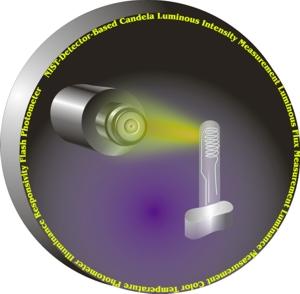
NIST is closely monitoring guidance from Federal, State, and local health authorities on the outbreak of COVID-19. To protect the health and safety of NIST employees and the American public they continue to serve, NIST has decided to postpone the event. For more information on COVID-19, please visit: cdc.gov/covid19. For questions regarding registration, please contact Karen.Startsman [at] nist.gov.
The need for education and training for photometry engineers and technicians has been stressed by the Council for Optical Radiation Measurements (CORM), Lamp Testing Engineer's Conference (LTEC), and other metrology groups within industry. In response to this need, Photometry Short Course was developed by Optical Technology Division of NIST and given since 1998.
The NIST Photometry Short Course is offered every two years and covers fundamentals in photometry, radiometry, and colorimetry and practical aspects of measurements of luminous flux, luminous intensity, illuminance, luminance, color temperature, and chromaticity of light sources. Participants will gain experience in the calibration of lamps, photometers, and colorimeters.
Dates TBD
NIST Gaithersburg, Maryland
The twelfth NIST Photometry Short Course is planned for three and half days at NIST Gaithersburg, Maryland. The course will consist of ten lectures given by NIST scientists and three laboratory sessions held in the NIST photometry laboratories using the 5 m photometry bench, the 2.5 m integrating sphere, and the color temperature measurement facility. Course participants are divided into three groups and will participate in actual measurements of luminous flux, luminous intensity and illuminance, and color temperature to gain experiences in the calibration of lamps, photometers, and colorimeters.
The course is limited to 21 participants. Those who are interested in attending the course, please contact c.miller [at] nist.gov (Cameron Miller) with your full contact information (name, affiliation, mailing address, email address, and phone number).
Who Should Attend:
This course is intended for photometry engineers and technicians in industries such as lighting, photography, and avionics; calibration and testing laboratories; instrument manufacturers; and others. Participants must have some basic knowledge and experience in photometric or radiometric measurements as well as calculus. The course is suited for those who want to learn photometry systematically in depth, in theory, and in experimental practice.
*Note that this course does not cover radiometry in general, for which another NIST course is available. For additional courses, see Short courses offered by the Sensor Science Division.
Tuesday, September 24, 2019:
8 am Registration
8:30 am Lecture Session
12:00 pm Lunch
1:30 pm Lab session 1
5:00 pm Adjourn
6:30 pm Dinner
Wednesday, September 25, 2019:
8:30 am Lecture Session
12:00 pm Lunch
2:00 pm Lab session 2
5:30 pm Adjourn
Thursday, September 26, 2019:
8:30 am Lecture Session
12:00 pm Lunch
2:00 pm Lab session 2
5:30 pm Adjourn
Friday, September 27, 2019:
8:30 am Lecture Session
10:30 am NIST Lab Tour
12:30 pm Adjourn
Instructors:
- Yoshi Ohno: NIST fellow. He authored the NIST SP250-37 Photometric Calibrations and two chapters in the OSA Handbook of Applied Photometry.
- Cameron Miller: Group Leader of Sensor Science Division at NIST.
- Yuqin Zong: Electronics engineer and the leader of the photometry project at NIST.
- Ben Tsai: Physical Scientist in Sensor Science Division at NIST.
Course Outline:
Basic concepts in photometry
• History of photometry and definition of the candela
• Relationship of radiometry and photometry
Quantities, units, and geometrical calculations
• Definitions of photometric units and quantities
• Flux transfer
Luminous intensity and illuminance measurement
• Standard lamps and standard photometers
• Measurement procedures
• Calibration of illuminance meters
Luminous flux measurement
• Reference standards
• Basic integrating sphere theories
• Measurement procedures
Goniophotometry
• Principles and design of goniophotometers
• Applications of goniophotometers
Fundamentals of colorimetry
• CIE colorimetry system
• Colorimeters and spectroradiometers
Color temperature and colorimetry of light sources
• Terms and definitions
• Measurement procedures
• Colorimetry of light sources
Luminance measurement
• Reference standards
• Measurement procedures
• Calibration of luminance meters
Uncertainty evaluation
• Basic concepts and terminology
• Construction of an uncertainty budget
Solid State Photometry
• Single LED measurements
• Terms and definitions
• Solid state lighting measurements
Laboratory Sessions
• Luminous intensity
• Luminous flux
• Correlated color temperature
If you are not registered, you will not be allowed on site. Registered attendees will receive security and campus instructions prior to the workshop.
NON U.S. CITIZENS PLEASE NOTE: All foreign national visitors who do not have permanent resident status and who wish to register for the above meeting must supply additional information. Failure to provide this information prior to arrival will result, at a minimum, in significant delays in entering the facility. Authority to gather this information is derived from United States Department of Commerce Department Administrative Order (DAO) number 207-12.
*New Visitor Access Requirement: Effective July 21, 2014, Under the REAL ID Act of 2005, agencies, including NIST, can only accept a state-issued driver’s license or identification card for access to federal facilities if issued by states that are REAL ID compliant or have an extension. As of Monday, January 30, 2017, Federal agencies will be prohibited from accepting driver’s licenses and identification cards from the following states for accessing federal facilities: Maine, Minnesota, Missouri, Montana and Washington. For further details, please visit the Campus Access and Security page.
Acceptable Photo Identification:
For Non-US Citizens: Valid passport for photo identification
For US Permanent Residents: Permanent Resident/Green card for photo identification

